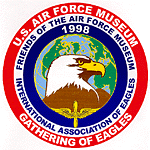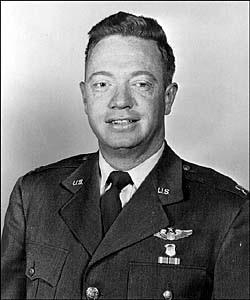
Joseph W. Kittinger, Jr., Col (Ret),
USAF
19-mile parachute jump, Vietnam POW, 1st solo balloon
crossing of the Atlantic Ocean
One of the 'Eagles' at
"The Gathering of Eagles"
9-10 October, 1998
(Biography not intended to be current)
 Joseph
Kittinger was born in Tampa, Florida, July 27, 1928, the son of Mr. and
Mrs. J.W. Kittinger. He was graduated from the Bolles School, Jacksonville,
Florida and attended the University of Florida.
Joseph
Kittinger was born in Tampa, Florida, July 27, 1928, the son of Mr. and
Mrs. J.W. Kittinger. He was graduated from the Bolles School, Jacksonville,
Florida and attended the University of Florida.
Entering military service in March, 1949, as an aviation cadet, he was commissioned a second lieutenant in March, 1950, at Las Vegas, Nevada. From 1950 to 1953 he served as a jet pilot in the 86th Fighter Bomber Squadron in Germany and then was assigned to the Air Force Missile Development Center (AFMDC) at Holloman Air Force Base, New Mexico.
On June 2, 1957, while stationed at the AFMDC, (then) Captain Kittinger made a balloon flight to 96,000 feet in the first flight of the Air Force's "Project Man High" preceding Lt. Col. Dave Simons, who went to 102,000 feet and 1st. Lt. Clifton McClure, who rose to 98,000 feet. For his "Man High I" flight, Captain Kittinger was awarded the Distinguished Flying Cross.
After being assigned to the Aerospace Medical Research Laboratories, Wright-Patterson AFB, Dayton, Ohio, Kittinger was appointed Test Director of "Project Excelsior," investigating escape from high altitude. During this project there were three high altitude jumps accomplished from a balloon-supported gondola--from 76,400 on November 16, 1958, from 74,700 25 days later, and on August 16, 1960, from 102,800 feet, the highest altitude from which man has jumped. In freefall for 4.5 minutes at speeds up to 714 mph and temperatures as low as -94 degrees Fahrenheit, Kittinger opened his parachute at 18,000 feet. In addition to the altitude record, he set records for longest freefall and fastest speed by a man (without an aircraft!) For work accomplished during the project, Captain Kittinger was awarded the C.B. Harmon Trophy, which was presented by President Eisenhower on October 3, 1960, an oak leaf cluster to the Distinguished Flying Cross, the J.J. Jeffries Award, the Leo Stevens Parachute Medal and the Wingfoot Lighter-Than-Air Society Achievement Award.
On December 13-14, 1962, Captain Kittinger, accompanied by Astronomer William C. White of China Lake, California, rose to an altitude of 82,200 feet in a balloon over Holloman AFB, New Mexico and hovered for 18.5 hours to check variations in brightness of star images caused by the atmosphere. The balloon astronomy experiment was dubbed "Project Stargazer." The specially-outfitted two-man gondola--weighing 4,800 pounds fully loaded for the flight--was fabricated in the shops of the Aeronautical Systems Division at Wright Field.
Kittinger volunteered for three combat tours in Vietnam and served as commander of the famous 555th "Triple Nickel" Tactical Fighter Squadron flying F-4s. He downed a MiG-21 before he himself was shot down on 11 May 1972, after which he spent 11 months in captivity as a POW. He subsequently continued his distinguished career and retired as a Colonel in 1978.
While working at Martin Marietta Aerospace as an engineer, he was able to devote his time to his old love of ballooning. He won the Gordon-Bennett balloon races in 1982, 1984 and 1985 before accomplishing his most ambitious feat, a solo balloon crossing of the Atlantic. On September 14, 1984, Joe Kittinger boarded a helium balloon called "Rosie O'Grady" to begin his most dangerous flight. After launch Kittinger traveled over 3,500 miles at altitudes ranging between 10,000 and 17,000 feet. Although beset by cold, fatigue, and tricky winds, he successfully completed the historic flight in 3.5 days. Crash-landing in northern Italy on 18 September, he set a record for the longest solo balloon flight as well as a distance record for this class of balloon.